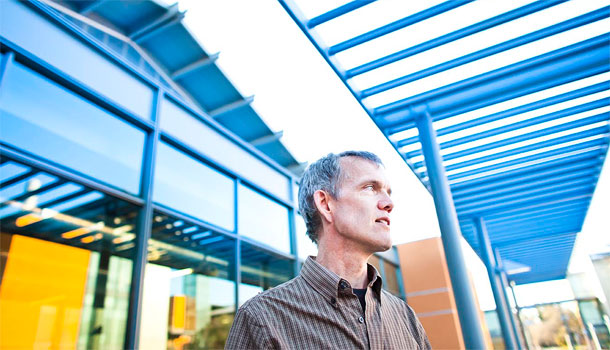
Green crusader
Wednesday 8 June 2011
A lab researcher's campaign to reuse, recycle and reduce draws national acclaim.
Allen Doyle saw how the Earth’s changing climate was effecting the environment while researching the disappearing permafrost of Alaska during the 1980s.
“I was an earth scientist studying what was going on in our natural systems but not doing anything to protect them. That bothered me,” Doyle said. He put “two and two together as a researcher and scientist” and acted on his beliefs by trying to use fewer resources in his workplace — the lab.
What started as a personal endeavor grew into a campuswide, grassroots organization to make labs greener at UC Santa Barbara. Now the sustainability manager at UC Davis, Doyle’s effort to promote sustainable practices has made him a nationally recognized expert in greening research labs. Science, the prestigious journal of the American Association for the Advancement of Science, profiled him for his advocacy.
Doyle’s crusade to reuse, recycle and reduce his impact on the environment began when he was the lab manager in the Ecology, Evolution and Marine Biology Department at UC Santa Barbara. He started doing things like reusing disposable plastics when possible, printing double-sided, cutting back or moving away from toxic chemicals, shutting off the lights in unoccupied rooms and turning off equipment that was not in use.
“I was doing a lot of these little things on my own,” Doyle said, while thinking “who else is doing anything about this and wondering how can I get more involved?”
He got more involved and his path to becoming a leading authority on green labs took hold in 2004 when he joined a sustainability committee at UC Santa Barbara. Doyle was asked to look into sustainable research that could help the campus cut its carbon footprint. But rather than review what the campus was researching, he focused on how a university conducts its research and teaching.
Labs, though they used a lot of resources, seemed to be left out of discussions about how to cut the campus’s carbon footprint due to concerns that changes could adversely affect research, Doyle said.
“If we’re going to make substantial reductions in greenhouse gases and energy use, labs have to be an important part of those reductions,” Doyle said.
Doyle came up with a list of best practices and formed a network of like-minded researchers to share ideas. In 2006, Doyle helped start a program at UC Santa Barbara called Laboratory Assessments for Research Sustainability (LARS) that looked at how labs could be part of the solution for cutting energy use and carbon emissions.
While big-ticket items such as installing new energy-efficient equipment or building green facilities certainly can help, changing behavior also is important.
“Just turning stuff off when it’s not being used can make a big difference,” Doyle said.
LARS identified ways that scientists could make labs more sustainable and offered to give on-site assessments and provide advice to researchers. At first not many labs were interested, but eventually researchers warmed to the idea. More than 30 labs have been given assessments by the program, which was renamed Laboratory Research and Technical Staff (LabRATS) Network.
LabRATs was “sort of a bottom-up approach. Now many [university] labs across the country are getting the top-down endorsement,” said Doyle, who took the sustainability manager job at UC Davis in 2008.
For example, an assessment of all current campus labs and early-phase construction designs of new labs by LabRATS is now “strongly encouraged” by an interim guideline added to the UC Santa Barbara sustainability policy in July 2010. Many university administrators now back energy conservation efforts such as tuning buildings to what scientists need rather than what is assumed and educating researchers on the simple steps they can take to become greener, Doyle said.
Programs similar to LabRATS are being conducted at varying degrees on existing labs on all UC campuses. Across the country, many universities are collaborating on best practices for sustainable labs, Doyle said.
And even outside of formal programs, some lab managers and researchers are realizing the impact they can have on the environment.
Professor Ichiro Nishimura, director of the Weintraub Center for Reconstructive Biotechnology at the UCLA School of Dentistry, said he became interested in how he could make his labs greener after reading the article about Doyle in Science.
“It made sense in that we are trying to contribute to our patient’s goodness but at the same time we may be wasting a lot of resources and contributing to the [campus’s] carbon footprint,” Nishimura said. “As scientists, we must be conscientious about what we’re doing and how we’re doing it.”
The Weintraub Center has worked with the UCLA Sustainability Committee, and students from the Institute of the Environment and Sustainability’s Action Research Teams to make its labs greener. The center has installed motion sensors that turn lights off in unoccupied rooms, implemented a recycling program for plastics and is exploring updating its fume hoods and freezers to more energy-efficient models.
Nishimura gave a presentation on the Weintraub Center’s researcher and student-driven sustainability programs at the 2008 California Higher Education Sustainability Conference, where he also met Doyle. “He was a big motivation to us,” Nishimura said.
Whether the inspiration is a magazine article or the Alaskan wilderness, researchers who make sustainability a priority can have the biggest impact on labs, Doyle said.
“Most effective programs have a network of eco leaders,” Doyle said. “Usually that person is already there. Everybody knows who it is: It’s the person who is turning off all the lights or picking up cans and putting them into recycling. Sometimes it’s the director; sometimes it’s a grad student. They set the bar, and that makes my job really gratifying to help them out.”